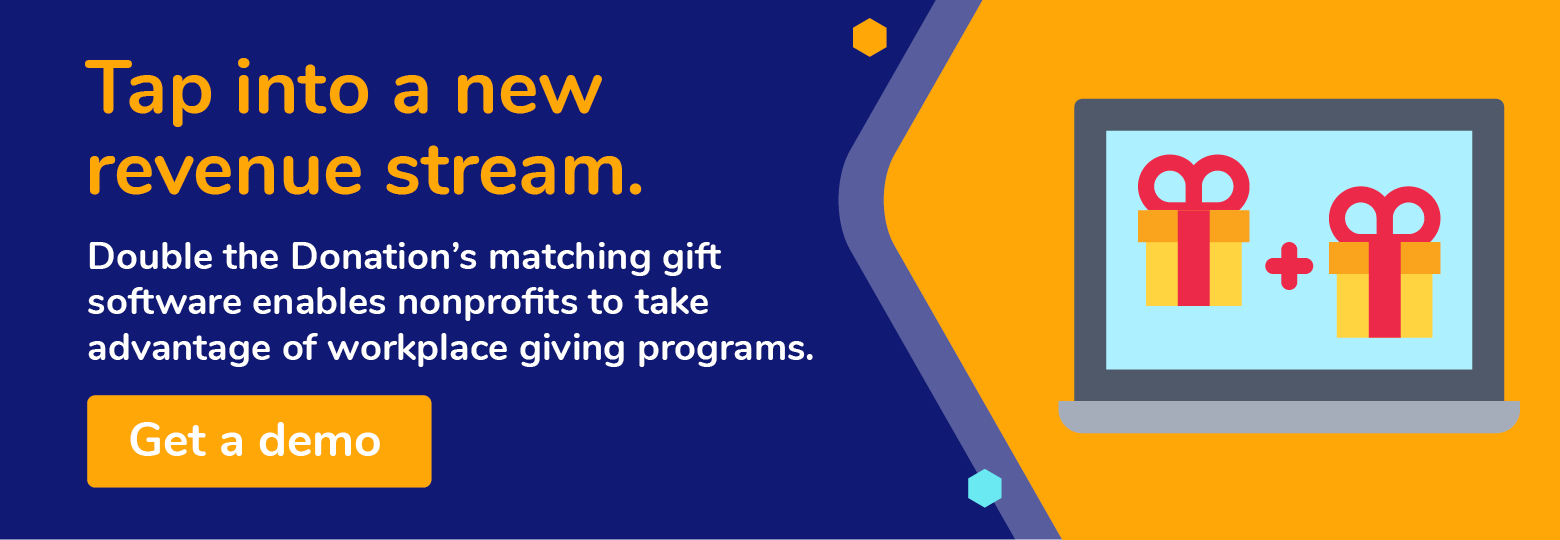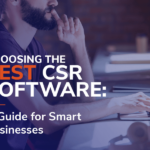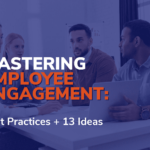Workplace Giving Software: What Nonprofits Need to Know

Corporate giving is consistently increasing. Over the course of just one year, corporations gave $20.77 billion to nonprofits. As a result, nonprofits have noticed the potential of workplace giving, and 49% of charitable organizations have identified it as a potential growth strategy.
To tap into this revenue source, nonprofit leaders should have a basic understanding of what workplace giving is, the modern software corporations use, and what tools their own organization can leverage to earn more from donors employed at companies with workplace giving programs. Additionally, while nonprofits only have so much influence over whether a company starts a workplace giving program, they still do have some influence, which can be leveraged to diversify their revenue.
For nonprofits interested in workplace giving, this guide will dive into how modern workplace giving software impacts these corporate philanthropy initiatives by answering these questions:
- What is workplace giving software?
- Why does workplace giving software matter to nonprofits?
- How can nonprofits promote workplace giving?
- What workplace giving software can nonprofits use?
Workplace giving software can refer to a variety of technologies, so let’s get started by defining it and setting the parameters of this guide.
What is workplace giving software?
Workplace giving software is any digital platform that enables corporate giving programs, such as matching gifts, volunteer grants, and corporate volunteerism.
Workplace giving software can be considereda type of employee engagement software. Employee engagement solutions help businesses improve the employee experience by developing better programs that help employees feel more fulfilled and appreciated at work.
Nonprofits can leverage software that enables donors to take advantage of their employers’ workplace giving programs, such as matching gift software. For the most part, however, businesses have some form of corporate social responsibility (CSR) software they use to track their employee-based philanthropic programs.
In this guide, we’ll focus primarily on platforms nonprofits can leverage to increase workplace giving, as well as strategies nonprofits can use to encourage donors to make better use of their employers’ workplace giving software.
Why does workplace giving software matter to nonprofits?
Nonprofits don’t use workplace giving software, but they can still reap the benefits of it. Leverage your donors’ passion and your relationships with businesses to persuade companies with workplace giving programs to consider systemizing them with software. As a result your nonprofit will benefit from:
- More revenue through CSR. Workplace giving software is essentially an optimization tool, automating the CSR process to make it faster, more efficient, and more organized. As a result, more employees can participate in their companies’ CSR efforts and subsequently donate to nonprofits like yours.
- Potential for new donors to find your nonprofit. Some workplace giving platforms have search tools that allow businesses to find specific nonprofits to support. As a result, your nonprofit may get discovered by an entirely new audience of corporate donors.
- Better donor interface. Companies without workplace giving software can still run employee giving programs. However, these programs will be low-tech and lack an organized interface. Professional software makes the entire workplace giving process feel more professional, increasing donor trust.
Additionally, nonprofits should understand the benefits of workplace giving software for companies to help better pitch the use of it. This might involve emphasizing the potential for increased employee participation, which in turn leads to more engaged employees.
How can nonprofits promote workplace giving?
On occasion, nonprofits will be able to interact directly with decision-makers at companies to discuss workplace giving. However, on a day-to-day basis, nonprofits can engage with donors to demonstrate the power of workplace giving to them.
Here are a few ways your nonprofit can remind donors to leverage their workplace giving program or advocate for their employer to start one:
Help donors identify their eligibility.
Just 8% of donors are aware of their employers’ matching gift programs, know they’re eligible, and know how to submit a matching gift form. These startlingly low numbers mean nonprofits need to do their part to educate donors about this essentially free way to make their donation more meaningful.
With the use of matching gift software, there are two ways nonprofits can help donors determine if they’re eligible for a matching gift. Essentially, when a supporter donates they can either:

- Enter their workplace email address. If donors choose to use their workplace email address as part of their contact information when they make a charitable contribution, matching gift software can pick up on it. Then, the software will automatically pull up their matching gift eligibility information and prompt them to complete a matching gift application.
- Search a matching gift database. If supporters use a personal email address when donating, they will be prompted to search for their employer using a matching gift search tool. The search tool accesses a database of thousands of employers’ matching gift information and can pair each donor with their employer, even if they spell their name wrong.
Advise donors to read their companies’ eligibility criteria carefully even after it’s automatically provided to them. Almost all matching gift programs have some requirements, such as minimum and maximum donation amounts, types of organizations that can be donated to, and whether they need to be employed full-time to receive matches.
Provide donors with tools to lobby for new workplace giving programs.
Passionate donors have the potential to get new workplace giving programs started. All your nonprofit needs to do is inspire them by fulfilling your mission and emphasizing the important role CSR initiatives play in your work. Then, provide them with the resources they need to advocate for a new program, such as:
- Educational materials about the basic process. For interested donors, provide materials that explain what a workplace giving program is and what steps a company would need to take to implement one. For example, let’s say an employee wants to advocate for a matching gift program. To help them out, provide materials that outline the requirements about which gifts should be matched that companies need to consider.
- Benefits breakdown. With any proposal, you need to explain why implementing your suggestion benefits whomever you’re persuading. Provide statistics you can share with companies, such as how workplace giving can boost employee retention or what percentage of consumers want to buy from companies that conduct CSR initiatives.
- Competitors analysis. Encourage donors to research similar companies to their employers that have workplace giving programs. Your nonprofit’s matching gift software can help you here, as you can easily search for other businesses and find comparisons. Competitor analysis can be persuasive as it shows companies that businesses of all sizes, from worldwide operations to mom-and-pop businesses, offer workplace giving programs.
Here’s an example letter template you might share with supporters to advocate for a workplace giving program:
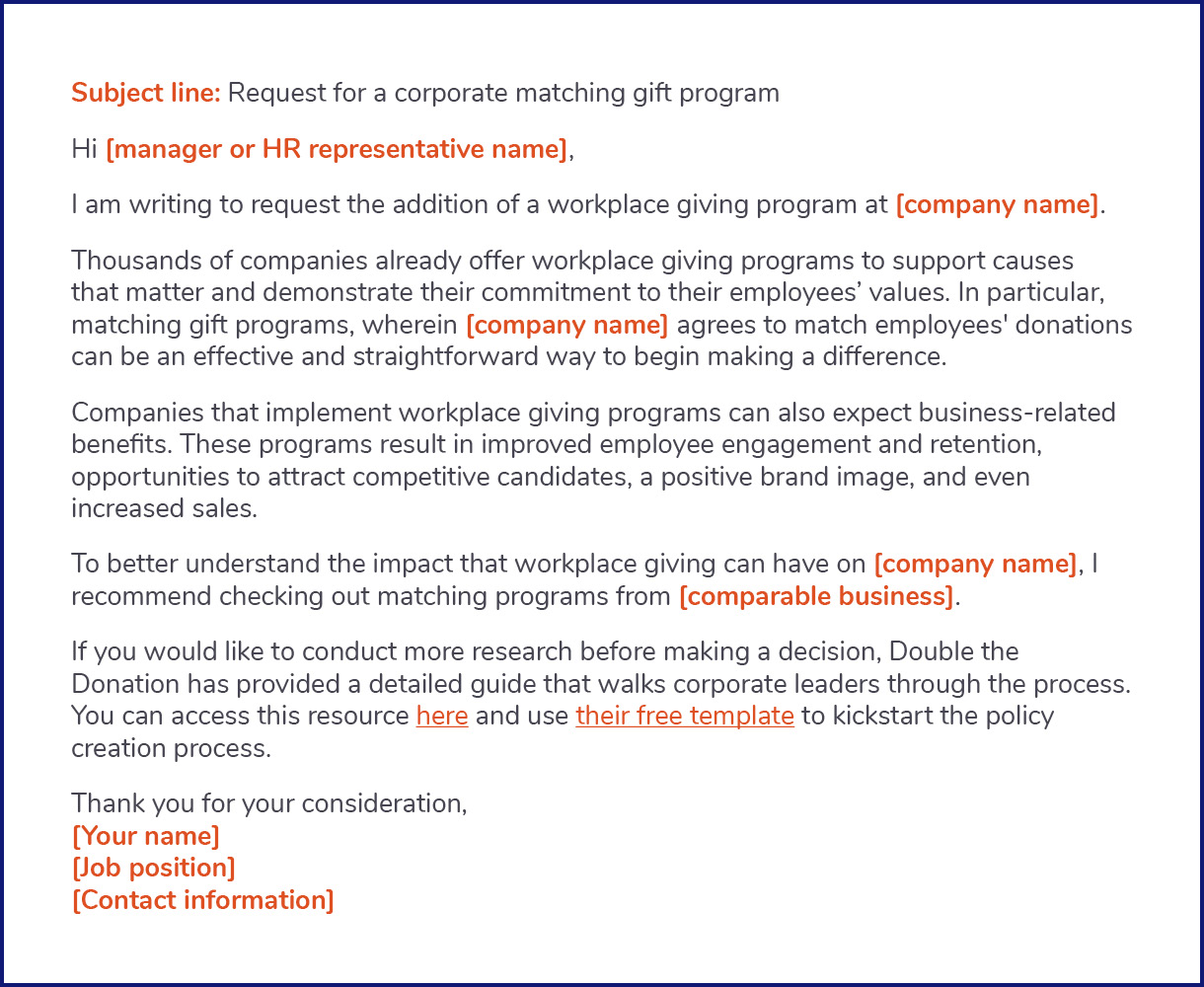
Hi [manager or HR representative name],
I am writing to request the addition of a workplace giving program at [company name].
Thousands of companies already offer workplace giving programs to support causes that matter and demonstrate their commitment to their employees’ values. In particular, matching gift programs, wherein [company name] agrees to match employees’ donations can be an effective and straightforward way to begin making a difference.
Companies that implement workplace giving programs can also expect business-related benefits. These programs result in improved employee engagement and retention, opportunities to attract competitive candidates, a positive brand image, and even increased sales.
To better understand the impact that workplace giving can have on [company name], I recommend checking out matching programs from [comparable business].
=If you would like to conduct more research before making a decision, Double the Donation has provided a detailed guide that walks corporate leaders through the process. You can access this resource here and use their free template to kickstart the policy creation process.
Thank you for your consideration,
[Your name] [Job position] [Contact information]
Additionally, more tech-savvy donors can also discuss the potential benefits of workplace giving software. For example, you may educate donors on how they can use their employers’ matching gift auto-submission tools to make the matching gift process faster and easier. Then, donors can recommend their employers consider technology like auto-submission functionality when selecting a CSR platform.
Help organize corporate volunteer days.
Outside of matching gift programs, nonprofits can coordinate other types of CSR activities, like corporate volunteerism. In particular, corporate volunteer days can help your nonprofit make progress on initiatives by recruiting more volunteers, while also strengthening your relationship with the business they work for. After all, employees are five times more engaged when their employer offers a volunteer program, making volunteerism an important part of any company’s philanthropy.
Essentially corporate volunteer days work like this:
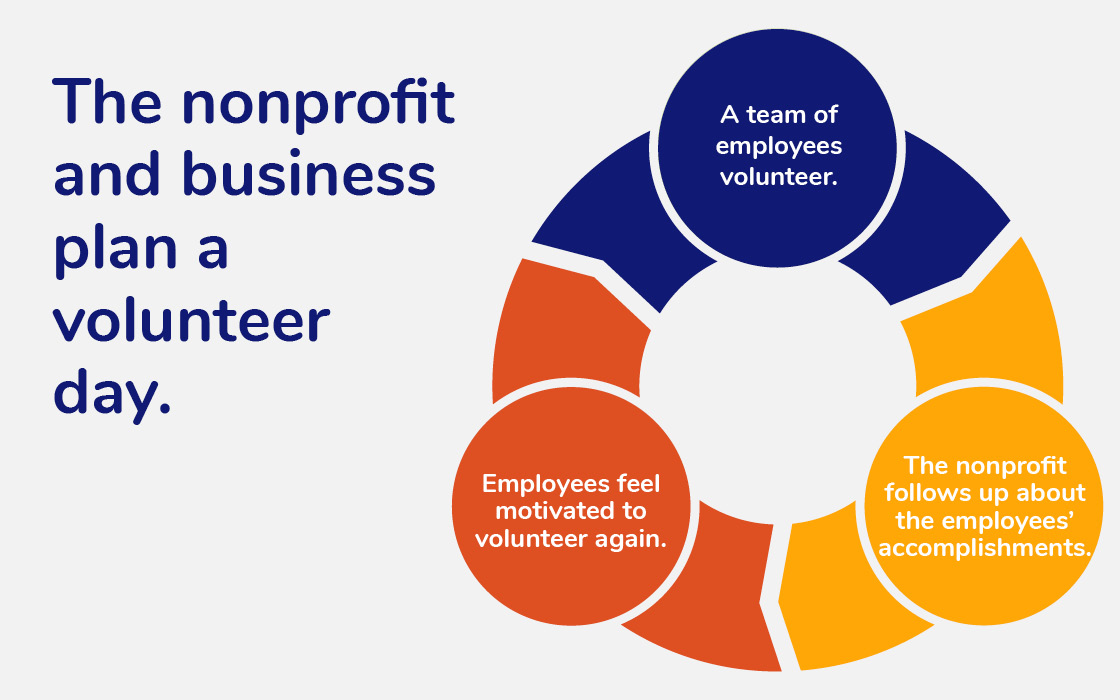
- The nonprofit and business leadership work together to plan a volunteer day. If your nonprofit has a relationship with a business, such as an organization that has sponsored you in the past or you have numerous donors work for, reach out to their leadership to plan a volunteer day. This volunteer day can be on a day the business is normally closed, such as a weekend, or, if the business is open to it, arrange for their team to volunteer on a specific day rather than going into work.
- A team of employees volunteer together. On your specified day, a team of corporate volunteers will arrive to help your nonprofit. Plan activities they can work on as a team. This will help them feel comfortable as they’ll be working with people they know, which can strengthen office relationships by giving them a new environment to work together in.
- The nonprofit follows up on the corporate volunteer team’s accomplishments. This last step can determine whether your volunteer day is a one-time event or becomes a recurring program. Share data with the volunteers and their employer about what they accomplished and how their efforts helped your mission. Even if the employer chooses not to organize a future volunteer day, individual employees who enjoyed the experience might be inspired to come back again.
If corporate volunteers aren’t possible for your nonprofit, you can still leverage workplace giving programs via corporate volunteer grants. Volunteer grants are donations businesses make to the nonprofits where their employees volunteer. In most cases, these donations will be a set amount for each hour an employee volunteers.
Both volunteer days and volunteer grants are easier to manage with a CSR platform. Volunteer grants especially benefit from a workplace giving solution that allows employees to fill out grant applications and report their volunteer hours.
Remind donors about workplace giving regularly.
Even donors who are excited to participate in workplace giving occasionally forget. Send regular reminders to your supporters to check their employers’ workplace giving details and take advantage of them. A few ways you can do this include your:
- Email newsletter. In your weekly or monthly newsletter, include a reminder to explore CSR opportunities. Inspire supporters by sharing examples of what these programs can accomplish, such as a recent corporate volunteer day your nonprofit arranged.
- Donation form. The easiest place to remind supporters about matching gifts is your donation form. Set your donation form confirmation page to remind supporters about checking their matching gift eligibility so they’ll be motivated to do it in the moment. For supporters who don’t, send follow-up emails thanking them for their gift and asking if they’d consider taking a moment to submit a matching gift application.
- Google Ads. If your nonprofit has the Google Ad Grant, you can attract attention to a variety of content on your website, including your matching gift program. When creating Google Ads for matching gifts, consider what keywords supporters are likely to search related to your cause and CSR. This might be longer phrase keywords, such as “how can I give more to [X] cause?”
Whenever a supporter does engage in workplace giving and contributes to your nonprofit, make sure to thank them. This helps build a relationship with the donor and increases the chances they’ll remember to participate in their workplace giving program again in the future.
What workplace giving software can nonprofits use?
As mentioned, you can use nonprofit software to help donors get involved with workplace giving. A few platforms nonprofits can use to engage in CSR programs include:
Prospect Research Tools
If your nonprofit is interested in reaching out to businesses to persuade them to consider starting a workplace giving program, you first need to research which organizations will be most receptive to your proposal. Prospect research tools can help you assess businesses by analyzing their:
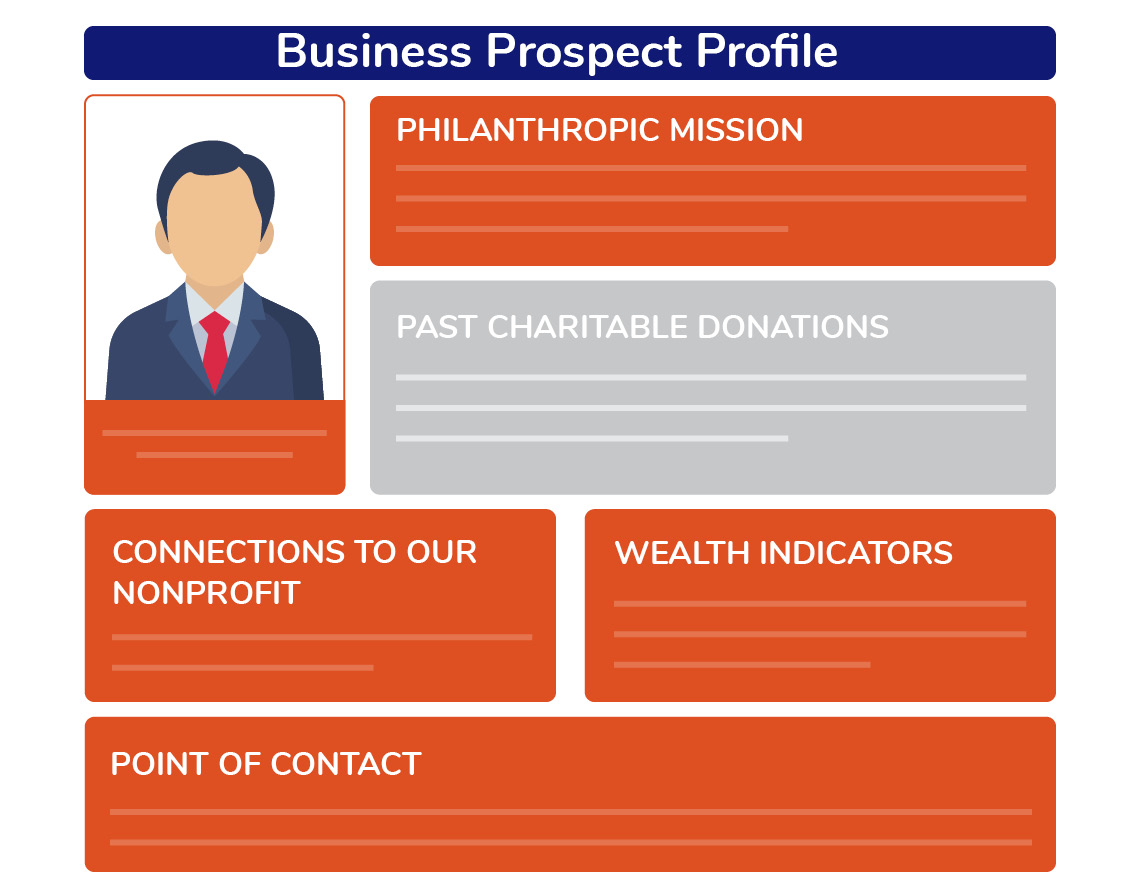
- Past philanthropic donations. Check companies’ philanthropic missions and how they align with your nonprofit’s cause. Outside of their stated CSR priorities, research if they have recently donated to nonprofits, what size those nonprofits are, and what causes they focus on.
- Wealth indicators. Outside of major philanthropic contributions, check businesses’ political contributions, stock prices, recent earnings reports, and any other data that provides a sense of their overall wealth.
- Connections. DDoes the business have any connections to your nonprofit? This might include having a large number of employees who donate to your nonprofit. In particular, look at your major donors for potential business connections. These donors are already invested in your organization and may be willing to introduce you to company leadership.
This data should help you create profiles of potential businesses to approach and your likelihood of success. When deciding to approach businesses, start with low and medium-priority prospects to give your team practice pitching your request.
Matching Gift Database
Nonprofits can provide donors with the information they need to participate in workplace giving with matching gift software. Embed matching gift software into your donation page to encourage donors to explore their eligibility while they’re in a giving mood.
Essentially, matching gift software connects your donors to a large matching gift database. This searchable database stores information about a wide range of companies’ matching gift programs and requirements. This includes details about donation maximums and minimums, who is eligible, and when the matching gift request must be submitted by.
All each donor needs to do is enter their employer’s name into the database to be paired with their information. For some donors, matching gift software can then automatically fill out their application request for them.
Matching Gift Auto-Submission
The latest technology in matching gift software is auto-submission. Auto-submission does what the name implies—it uses donor information to automatically complete matching gift applications for them and submit them to their employer.
Here’s a breakdown of how auto-submission works:
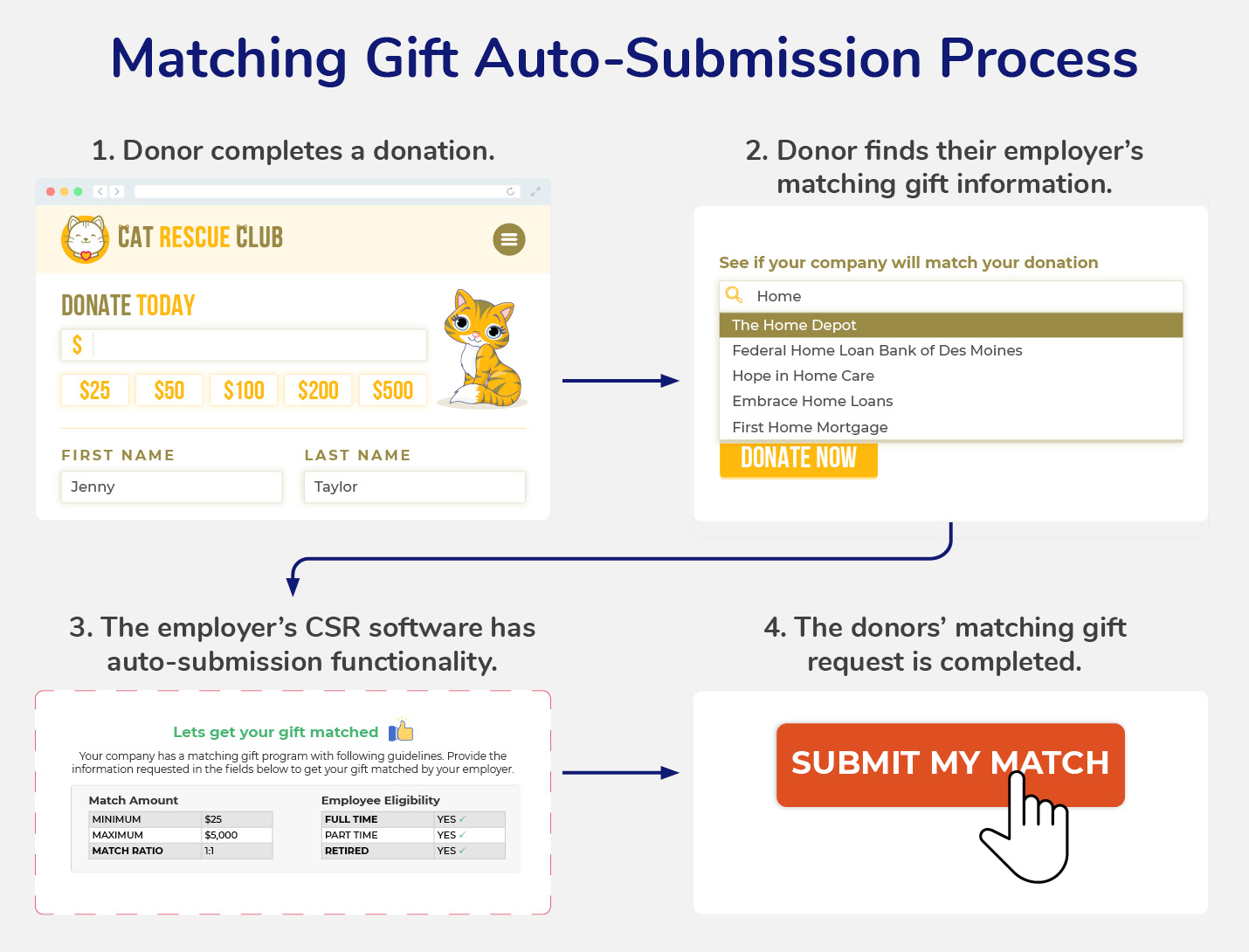
- Donor completes a donation. Supporters complete their donations as normal. Afterward, they’ll be prompted to check their matching gift eligibility.
- Donor finds their employer’s matching gift information. Once a donor confirms their employer by either using a work email address or searching them in the matching gift database, they’ll be paired with their matching gift information.
- The employer’s CSR software has auto-submission functionality. The employer must use a CSR platform that has auto-submission. If they do, then the form can be completed automatically. If not, the supporter needs to fill out the application form themselves.
- The auto-submission tool completes the donor’s matching gift request for them. For those who can participate in auto-submission, their matching gift request can be submitted in just a few clicks, saving time and earning your nonprofit more revenue.
Currently, auto-submission is still a new tool, and many corporations have yet to adopt it. However, for those who have or are considering implementing it, your nonprofit can be ready with matching gift software and auto-submission technology of your own.
eCard Platform
One of the greatest challenges to raising more from corporate giving programs is a lack of employee awareness about these initiatives. In fact, according to Double the Donation, $4-$7 billion in matching gift funds goes unclaimed each year.
To raise more from these sources, your nonprofit can launch marketing and awareness campaigns that share information about the impact of matching gifts and other corporate philanthropy programs. An eCard platform can help you spread the word to potential donors using eye-catching eCards that are branded to your nonprofit.
You can use an eCard platform to:
- Share information about the positive impact of corporate philanthropy on your nonprofit’s mission.
- Show appreciation for donors who participate in workplace giving programs.
- Allow donors to create their own eCards to send to family and friends and let them know about their donation.
eCards can help your message stand out from other emails that donors receive. They’re a low-cost, eco-friendly way to spread the word about the benefits of workplace giving for your nonprofit and how easy it is for donors to get involved.
Conclusion + Additional Resources
Workplace giving software transforms how businesses conduct CSR, and this matters for everyone involved in the employee giving process, including your nonprofit. Knowing more about these programs enables you to advocate for their creation, earn more funds through them, and speak frankly to your corporate partners about what to expect when starting one.
If you’re interested in learning more about workplace giving and what it means for your nonprofit, check out these informational resources on corporate philanthropy and nonprofit technology:
- What is Corporate Giving? The Ultimate Guide to Earning More. Still have questions about CSR and employee giving programs? Check out this complete guide to continue your research.
- From Cubicle to Community: How to Empower Workplace Giving. Peak behind the curtain to see how businesses approach workplace giving.
- How Technology Can Automate Nonprofit Operations: 3 Benefits. Interested in how your nonprofit can automate other day-to-day processes? Explore this guide to nonprofit automation.



